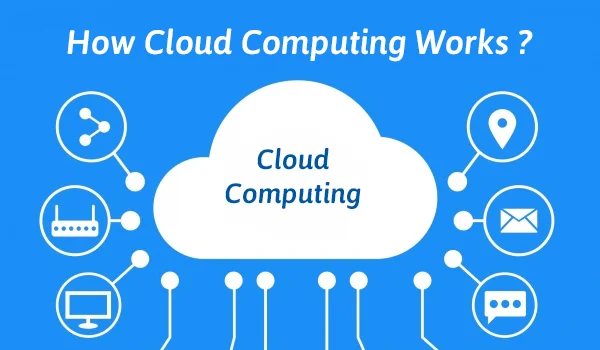How does Cloud Computing Work? Cloud computing has revolutionized the way businesses and individuals access and manage computing resources. It represents a paradigm shift from traditional on-premises infrastructure to a dynamic, scalable, and on-demand model.
In this article, we delve into the core principles of how cloud computing works, exploring the underlying technologies and the myriad benefits it offers.

How Does Cloud Computing Work – Definition of Cloud Computing
At its essence, cloud computing refers to the delivery of computing services, including storage, processing power, and applications, over the internet. Rather than relying on local servers or personal devices to handle computing tasks, users can access and leverage these resources from a remote data center – the cloud.
How Does Cloud Computing Work – Key Components and Models
- Infrastructure as a Service (IaaS): IaaS provides virtualized computing resources over the internet. Users can rent virtual machines, storage, and network infrastructure on a pay-as-you-go basis. This model allows for greater flexibility and scalability, as users can scale their infrastructure up or down based on demand.
- Platform as a Service (PaaS): PaaS delivers a platform that includes not only the underlying infrastructure but also the tools and services needed to develop, deploy, and manage applications. Developers can focus on coding without worrying about the underlying infrastructure, streamlining the application development process.
- Software as a Service (SaaS): SaaS delivers fully functional software applications over the internet. Users can access these applications through a web browser without the need for installation or maintenance. Examples include web-based email services, office suites, and customer relationship management (CRM) software.
- Public, Private, and Hybrid Clouds: Cloud computing services can be categorized based on their accessibility and ownership. Public clouds, owned and operated by third-party providers, are accessible to anyone over the Internet. Private clouds, on the other hand, are dedicated to a single organization, offering increased control and customization. Hybrid clouds combine elements of both public and private clouds, allowing data and applications to move seamlessly between them.
How Does Cloud Computing Work – Working Mechanism
- Resource Virtualization: At the core of cloud computing is the concept of virtualization. Virtualization allows the abstraction of physical resources (such as servers, storage, and network) into virtual instances. This enables multiple virtual environments to run on a single physical server, optimizing resource utilization.
- On-Demand Self-Service: Cloud computing users can provision and manage computing resources on demand, without requiring human intervention from the service provider. This self-service aspect empowers users to scale their resources up or down based on their current needs.
- Broad Network Access: Cloud services are accessible over the internet from a variety of devices, such as laptops, smartphones, and tablets. This ubiquitous access ensures that users can connect to their cloud resources anytime, anywhere, as long as they have an internet connection.
- Rapid Elasticity: Cloud resources can be rapidly scaled to accommodate changing workloads. This elasticity allows users to handle peaks in demand without over-provisioning resources during periods of lower demand, thereby optimizing costs.
- Measured Service: Cloud computing providers implement a pay-as-you-go model, where users are billed based on their actual usage of resources. This metered approach allows for cost-effective resource allocation, as users only pay for the computing power and storage they consume.
How does Cloud Computing Work – Benefits of Cloud Computing
- Cost Efficiency: Cloud computing eliminates the need for organizations to invest in and maintain on-premises hardware. With a pay-as-you-go model, businesses can optimize costs by only paying for the resources they use.
- Scalability and Flexibility: Cloud services offer unparalleled scalability, allowing organizations to quickly scale up or down in response to changing business requirements. This flexibility ensures that computing resources align with current needs.
- Accessibility and Collaboration: The cloud enables users to access their data and applications from anywhere with an internet connection. This fosters collaboration among geographically dispersed teams, enhancing productivity and efficiency.
- Reliability and Redundancy: Cloud providers invest in robust infrastructure, ensuring high availability and reliability. Redundant systems and data backups minimize the risk of data loss and downtime.
Conclusion
How does Cloud Computing Work? In the ever-evolving landscape of technology, cloud computing stands as a transformative force, reshaping how computing resources are provisioned, accessed, and managed. By embracing the principles of virtualization, on-demand self-service, and scalability, cloud computing empowers organizations to achieve greater efficiency, flexibility, and innovation in their digital endeavors. As we continue to witness advancements in cloud technologies, the role and impact of cloud computing are bound to grow, influencing the future of how businesses and individuals interact with computing resources.
